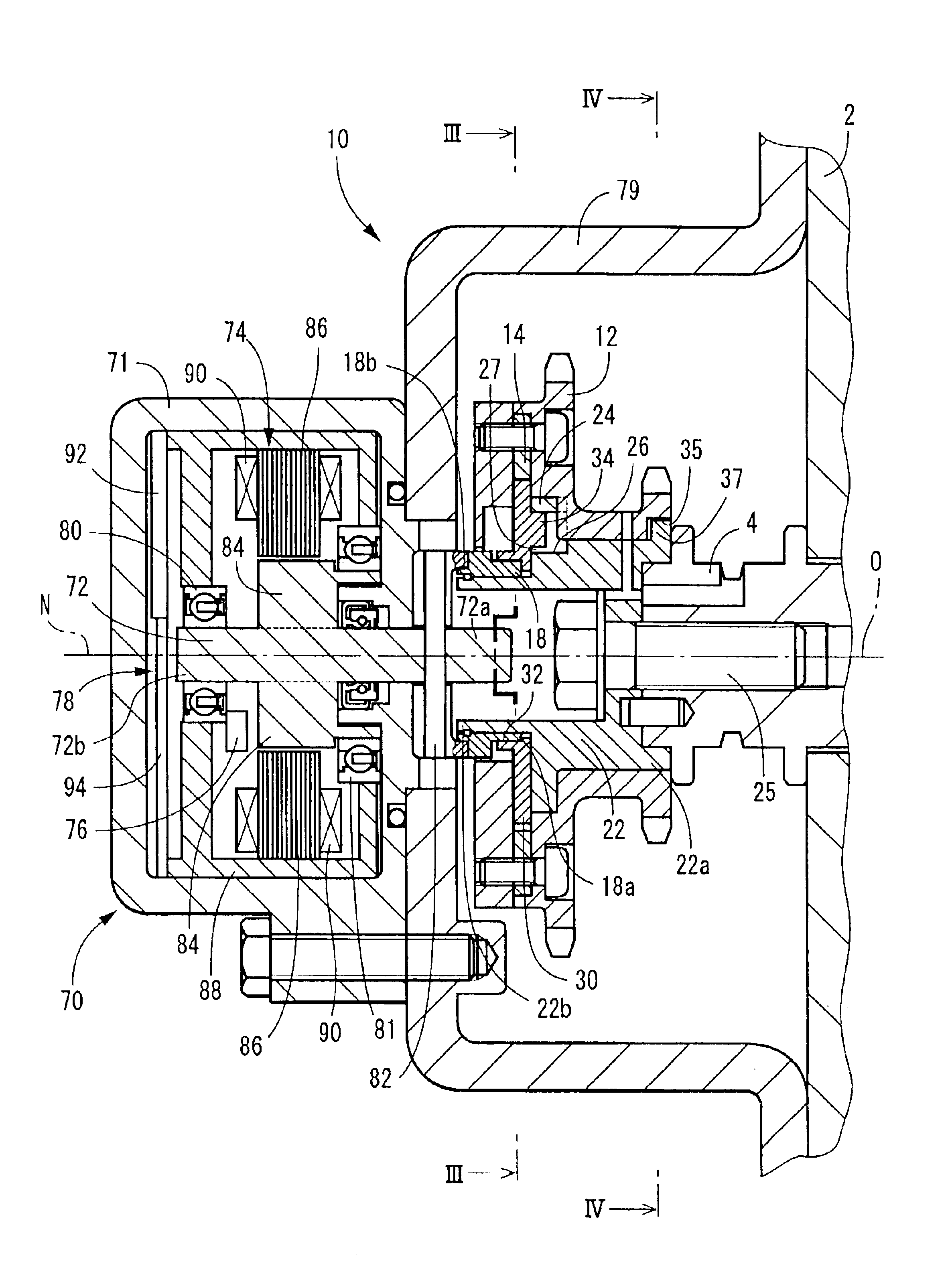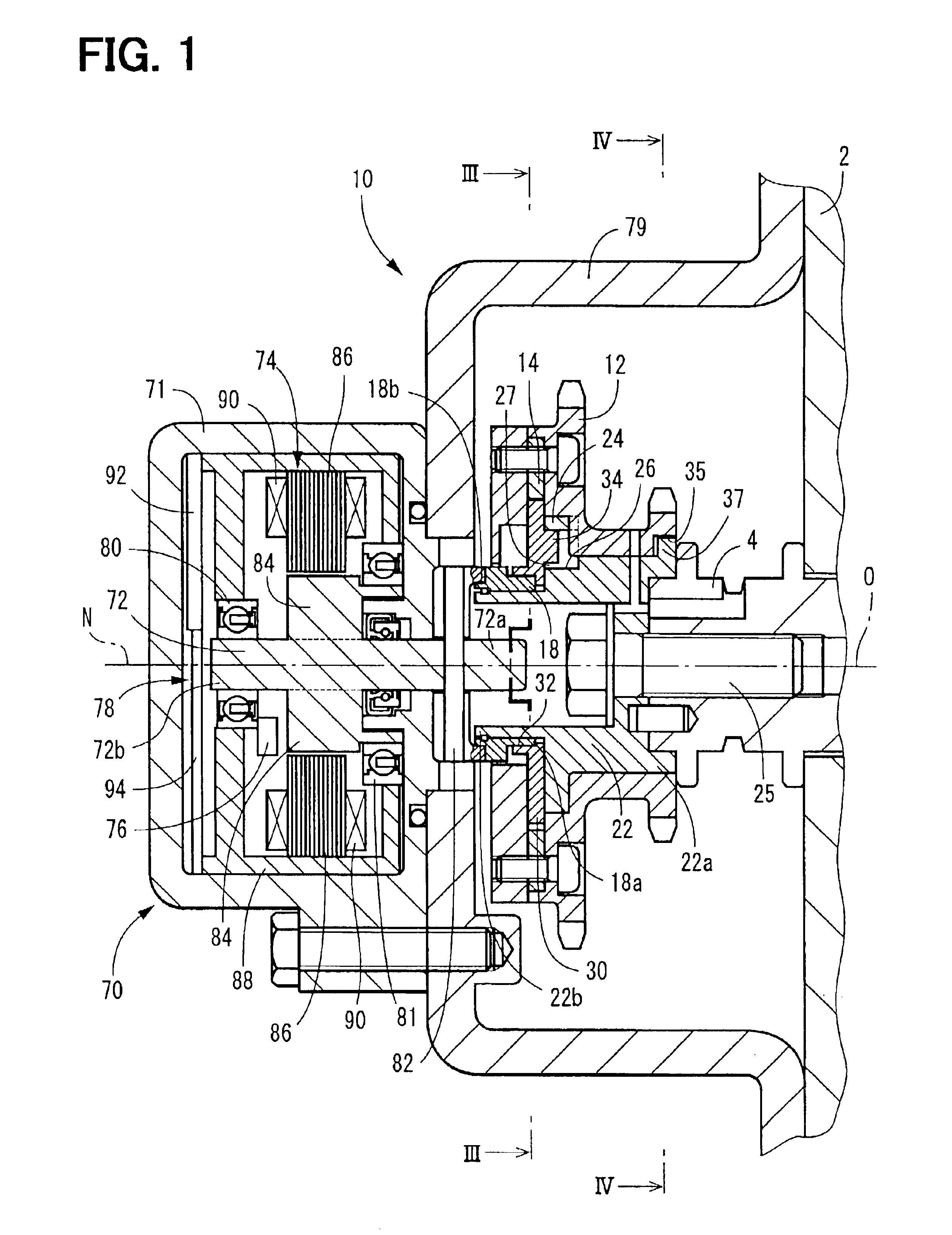Valve timing adjusting device
a timing adjustment and valve technology, applied in the direction of valve details, valve arrangements, non-mechanical valves, etc., can solve the problems of low durability, radio noise, deterioration of device durability, etc., to prevent the rotation of the input shaft, enhance or produce friction, and high accuracy
- Summary
- Abstract
- Description
- Claims
- Application Information
AI Technical Summary
Benefits of technology
Problems solved by technology
Method used
Image
Examples
first embodiment
A valve timing adjusting device for an engine according to a first embodiment of the present invention is illustrated in FIGS. 1 to 4. The valve timing adjusting device 10 of this embodiment controls a rotational phase of a camshaft that drives intake valves of an engine 2, thereby it adjusts valve timing of the intake valves.
The valve timing adjusting device 10 is provided in a transmission system which transfers a driving torque on a crankshaft in the engine 2 to a camshaft 4 in the engine. The camshaft 4 is adapted to rotate about its axis O to open and close intake valves in the engine2. The axis O is referred to as a cam axis. The crankshaft of the engine 2 constitutes a drive shaft and the camshaft 4 constitutes a driven shaft.
A sprocket 12 is supported on an outer periphery wall of an output shaft 22 to be described later in a relatively rotatable manner about the cam axis O. A power transmitting member such as a chain, a gear train or a belt couples the sprocket 12 and the c...
second embodiment
A valve timing adjusting device according to a second embodiment of the present invention is illustrated in FIG. 6, in which substantially the same constituent portions as in the first embodiment are identified by like reference numerals.
In the valve timing adjusting device 100 according to this second embodiment, a coned disk spring 102 as a friction member is interposed between a planetary gear 30 and a sprocket 12. An end portion 102a on a large diameter side of the coned disk spring 102 is fixed to the sprocket 12, while an end portion 102b on a small diameter side of the coned disk spring 102 is pressed for sliding contact against an outer wall on an anti-engaging portion side of the planetary gear 30. According to this construction, when the planetary gear 30 tries to rotate relatively with respect to the sprocket 12, a frictional force proportional to a resilient characteristic of the coned disk spring 102 is generated in the slide contact portion between the coned disk sprin...
third embodiment
A valve timing adjusting device according to a third embodiment of the present invention is illustrated in FIGS. 7 and 8, in which substantially the same constituent portions as in the first embodiment are identified by like reference numerals.
In the valve timing adjusting device 150 of this third embodiment, an inner periphery wall of each of engaging holes 26 formed in an output shaft 22 is tapered so as to be larger in diameter toward an opening 27 side in which a corresponding engaging lug 34 in the planetary gear 30 is inserted. An outer periphery wall of each engaging lug 34 is tapered so as to be smaller in diameter toward a projecting tip portion 34a. Each engaging lug 34 is supported at a base portion 34b thereof by a body 31 of a planetary gear 30 so as to be movable to both sides in a central axis Q direction, and is urged in the direction of insertion into the corresponding engaging hole 26 by means of a coiled spring 152 as an urging means. In this embodiment, as shown ...
PUM
 Login to View More
Login to View More Abstract
Description
Claims
Application Information
 Login to View More
Login to View More - R&D
- Intellectual Property
- Life Sciences
- Materials
- Tech Scout
- Unparalleled Data Quality
- Higher Quality Content
- 60% Fewer Hallucinations
Browse by: Latest US Patents, China's latest patents, Technical Efficacy Thesaurus, Application Domain, Technology Topic, Popular Technical Reports.
© 2025 PatSnap. All rights reserved.Legal|Privacy policy|Modern Slavery Act Transparency Statement|Sitemap|About US| Contact US: help@patsnap.com



